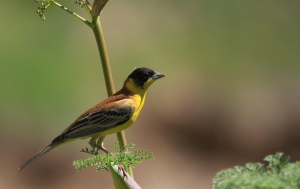AllCampgrounds Nature-Watching Series: The Best in Bird Watching

The black-headed bunting, one of about 2,000 bird species in North America
Photo by: Akbar Nemati (Stock Exchange)
Today on AllCampgrounds, we embark on a whole new journey to find the best camp grounds for your nature-watching needs.
Just about everyone who loves camping loves to enjoy nature up close, and there’s no better way to enjoy it than a good, clear view of local wildlife you just can’t see day-to-day.
Of course, we all know that you’ve got to “leave no trace”, and nobody is better at this than experienced bird watchers. So, to get started, we’ll be picking out the best of all campsites for birding.
Great Camp Grounds and Guides for Birding
Chickasaw National Recreation Area: Chickasaw, in Oklahoma, is the home of the famous annual Bald Eagle Watch Tour. During the winter, the area sees up to 1,000 migratory bald eagles, and is one of the most important regions for the ongoing return of this once-endangered species to American skies. Eagle watch programs are abundant from October to January, as the locals are justly proud of their role in protecting eagle habitats. There are six public camp grounds to choose from, including year-round tent camping near the Lake of the Arbuckles, which is prime birding territory.
Bean’s VIP Campground: Bean’s, on the eastern edge of Texas in Sabine County, is one of the smaller campgrounds we’ve showcased here: it has only 20 RV sites and 8 places for tenting, all campsites including both water and electric. But where it really shines is in the huge variety of activities for seeing and enjoying wildlife, including bird watching. The camp area is home to over 40 species of bird, including the bald eagle, great blue heron, cardinal, painted bunting, and many more. For birding photos from around the park and region, click to the Toledo Bend Gallery, an affiliated site.
Coronado National Forest: Sprawled across almost two million acres in southern Arizona and New Mexico, Coronado National Forest offers a lush variety of local desert and forest dwellers for your viewing pleasure. For maximum birding fun, try out Tohono Chul Park, occupying a corner of Coronado. There are plenty of guided tours, outreach programs, and other great cultural enrichment activities set at Tohono Chul, and you can see curve-billed thrashers, cactus wrens, and other southern species.
Bryce Canyon National Park: Found in Bryce, Utah, Bryce Canyon has a rim elevation up to 9,100 feet and is pleasant for most of the year, though snowfall and sub-freezing temperatures can occur between October and April. Bryce is known for stargazing, which has been organized in the valley for almost 50 years, and – of course – bird watching. Bryce is a great place to start an amateur birding odyssey, since – in addition to terrific tent camping and the kind of service you’d expect from a national park – it offers all kinds of materials to help you find local birds. Check out the Bird Checklist, for example. Plus, a quick search yields detailed pages on just about every native species.

